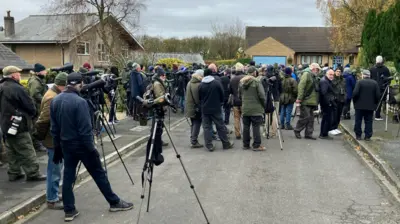We've updated our Privacy and Cookies Policy
We've made some important changes to our Privacy and Cookies Policy and we want you to know what this means for you and your data.
Map highlights dangers of discarded balloons
Image source, James Elliott
- Author, Eleanor Maslin
- Role, BBC News
Two litter-pickers from Grimsby have created a map of discarded balloons to highlight the dangers they present to wildlife.
It documents where latex and foil balloons – let off for events including memorials, birthdays and gender reveals – have fallen to earth.
Zac Robinson, who picks litter with his dog, and James Elliott, otherwise known as the Canoe River Cleaner, began compiling the interactive map last year.
They felt "something had to be done" because balloons were being found "almost daily" in fields, woods, rivers and on beaches.
Image source, James Elliott
The men say balloons can "be fatal" when swallowed by animals, as they can block digestive and respiratory tracts.
They are hoping to encourage alternative ways of remembering loved ones by working with local organisations such as memorial tree planting services.
At present, their map focuses on Lincolnshire, but includes some locations further afield, including the Peak District and Newcastle.
Mr Elliott, 48, who is known for his work cleaning the River Freshney, told BBC Radio Humberside: "We're trying to gently highlight the issue with this map and if it's interactive people can spread this awareness for us."
Image source, Google
He added: "Even if you're extremely religious, I think you would admit that these balloons potentially don't go to heaven.
"It's about changing hearts and minds in a positive and creative way."
The pair are planning to open up the map to other litter-pickers, who will be asked to submit data on their finds.
Mr Robinson, 33, who runs a Facebook page called Pick Walks, said he hoped that the map would provide a "permanent and interactive way of showing just how problematic a released balloon is".
Image source, Zac Robinson
According to the Marine Conservation Society, three balloons per 100m (328ft) were found during the Great British Beach Clean over the past five years.
In a policy on the use of council-owned land, North East Lincolnshire Council states that "the release of helium balloons and paper lanterns powered by tea lights are not permitted".
Follow BBC Lincolnshire on Facebook, X (formerly Twitter), and Instagram. Send your story ideas to eastyorkslincs.news@bbc.co.uk
Top Stories
More to explore
Most read
Content is not available








